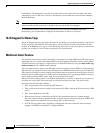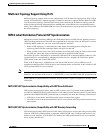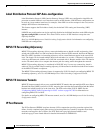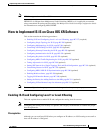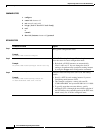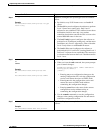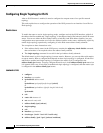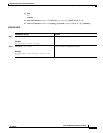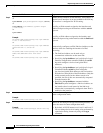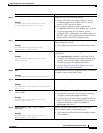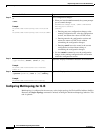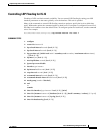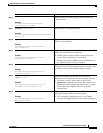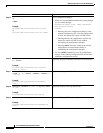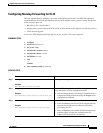
Implementing IS-IS on Cisco IOS XR Software
How to Implement IS-IS on Cisco IOS XR Software
RC-282
Cisco IOS XR Routing Configuration Guide
OL-14356-01
Step 3
ipv4 address address mask
or
ipv6 address ipv6-prefix/prefix-length [eui-64]
or
ipv6 address ipv6-address {/prefix-length
| link-local}
or
ipv6 enable
Example:
RP/0/RP0/CPU0:router(config-if)# ipv4 address
10.0.1.3 255.255.255.0
or
RP/0/RP0/CPU0:router(config-if)# ipv6 address
3ffe:1234:c18:1::/64 eui-64
or
RP/0/RP0/CPU0:router(config-if)# ipv6 address
FE80::260:3EFF:FE11:6770 link-local
or
RP/0/RP0/CPU0:router(config-if)# ipv6 enable
Defines the IPv4 address for the interface. An IP address is
required on all interfaces in an area enabled for IS-IS if any
one interface is configured for IS-IS routing.
or
Specifies an IPv6 network assigned to the interface and
enables IPv6 processing on the interface with the eui-64
keyword.
or
Specifies an IPv6 address assigned to the interface and
enables IPv6 processing on the interface with the link-local
keyword.
or
Automatically configures an IPv6 link-local address on the
interface while also enabling the interface for IPv6
processing.
• The link-local address can be used only to
communicate with nodes on the same link.
• Specifying the ipv6 address ipv6-prefix/prefix-length
interface configuration command without the eui-64
keyword configures site-local and global IPv6
addresses.
• Specifying the ipv6 address ipv6-prefix/prefix-length
command with the eui-64 keyword configures
site-local and global IPv6 addresses with an interface
ID in the low-order 64 bits of the IPv6 address. Only the
64-bit network prefix for the address needs to be
specified; the last 64 bits are automatically computed
from the interface ID.
• Specifying the ipv6 address command with the
link-local keyword configures a link-local address on
the interface that is used instead of the link-local
address that is automatically configured when IPv6 is
enabled on the interface.
Step 4
exit
Example:
RP/0/RP0/CPU0:router(config-if)# exit
Exits interface configuration mode, and returns the router to
global configuration mode.
Step 5
router isis instance-id
Example:
RP/0/RP0/CPU0:router(config)# router isis isp
Enables IS-IS routing for the specified routing instance, and
places the router in router configuration mode.
• By default, all IS-IS instances are Level 1 and Level 2.
You can change the level of routing to be performed by
a particular routing instance by using the is-type
command.
Command or Action Purpose



